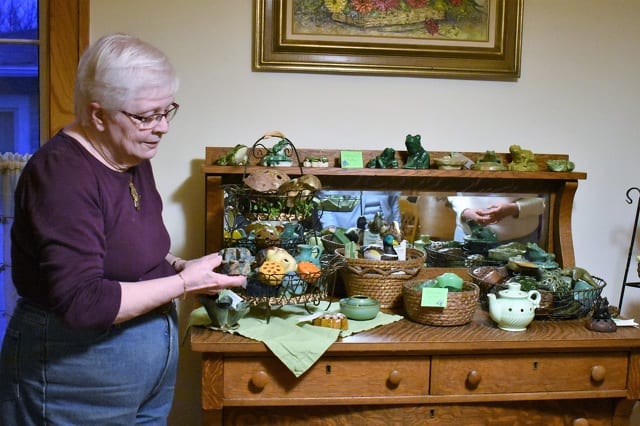If the frog of your imagination is a smooth-skinned amphibian that hangs out in moist areas of the garden, you’d be right, but it isn’t the only one. There is another type of lesser-known frog — the flower frog.
This frog is a bouquet-arranging tool with holes or pins. It holds stems of flowers in place in a bowl or vase and has been doing so since a practical pyramid style arranger was patented in the United States way back in 1875.
No one is sure where the term flower “frog” originated. It may be because the device sometimes squats in water, much like its namesake.
Recently, I was treated to an enjoyable presentation about flower frogs by Rosalie Bloom-Brooks, president of the Ferguson Township Garden Club, who has been gathering these beautiful artsy treasures ever since the first green Depression era one was gifted to her at the age of 13 by her neighbor.
According to an article in Vintage Garden Style magazine, the use of flower frogs is believed to date back to 13th-century Persia with vases with side spouts, and in early ikebana, a Japanese flower-arranging art form, where the frogs were made from things like charcoal chunks, wads of straw or small stones.
Once flower frogs caught on here in the United States, they were all the rage in the 1920s and ’30s, with figures made from glass and pottery.
Bloom-Brooks shared highlights of her extensive collection, which includes lovely green satin as well as carnival glass, metal trench art, ceramic figures, hairpin and metal loop arrangers, and needlepoint holders. Many of the pottery frogs were, not surprisingly, of aquatic motifs — frogs, turtles, fish or lily pads — and came in all sizes.
According to Bloom-Brooks, two names stand out in the annals of flower frog history.
The first is Ida Sinclair, of Cuyahoga Falls, Ohio, a continual first-prize winner of the famous Ohio State Fair flower arranging contest. No one could figure out the secret to her perfect arrangements until it was revealed that she had crafted a homemade frog out of a lead base spouting bent bobby pins. She went on to patent her invention, the Blue Ribbon Flower Holder, in 1936. It is still being manufactured today, as pictured in a recent Charleston Gardens catalog.
The second person of note is V. L. Smithers, a chemist from Akron, Ohio, who in 1954 invented Oasis, a wetable floral foam, which ended up replacing frogs in professional flower arrangements.
Today, vintage flower frogs are more difficult to find. They may be at yard sales or online and can be worth anywhere from 5 cents to $10 for a typical basket, needle and glass block frog, up to $2,000 or more for a flower frog and bowl made by Tiffany and Co.
I came home with a new-found appreciation of the variety and beauty of these vintage garden collectibles.
MUDDY PAWS FROG FEST 2017
If all this talking about frog objects has given you a desire to see the real things in their own environment, be sure to head out to the Penn State Extension Frog Fest 2017 at Muddy Paws Marsh on Saturday, May 13, from 3 to 6:30 p.m. There is no charge, and the program will occur rain or shine.
Muddy Paws Marsh is in the wetlands next to the Cooke Tavern near Spring Mills at 4158 Penns Valley Road, home of Greg and Mary Kay Williams. This will be a fun day for the kids (as well as their adults), in boots and old clothes, to learn about wetland conservation and enjoy nature through hands-on learning stations that feature art and science.
Mary Kay Williams tells me that at Muddy Paws there are five species of frogs and toads — the spring peeper, American toad, pickerel frog, green frog and the bullfrog. These all undergo metamorphosis, in which eggs hatch into tadpoles that feed on algae and eventually form into froglets and mature adults. Both toads and frogs reproduce and develop in water, and both eat insects such as flies and mosquitos; larger frogs even eat small snakes, mice and baby turtles.
On hand will be Jim Julian, an instructor in biology at Penn State-Altoona who has been involved in amphibian research with the U.S. Geological Survey and National Park Service and who loves to teach children about frogs and fun in nature. The nature stations will be presented by Penn State Extension Master Gardeners of Centre County, Shaver’s Creek Environmental Center and Penns Valley Conservation Association.
FROG FACTS AND FUTURE
Here are a few surprising facts about real frogs, courtesy of Smithsonian.com.
■ There are more than 4,800 authenticated species worldwide, many in tropical rainforests.
■ A group of frogs is called an army, colony or knot.
■ A frog completely sheds its skin about once per week.
■ The deadly golden poison dart frog can kill 100,000 people with 1 gram of the toxin its skin produces.
■ A frog blinks while swallowing its prey. This pushes its eyeballs down on top of its mouth to help push the food down its throat.
“Frogs are some of the most fragile, most environmentally vulnerable species on earth. They are our mining canaries for the entire planet,” according to Bill Hamilton, assistant professor of biology at Penn State’s New Kensington campus. “It’s the same permeable skin that sometimes serves in their defense that makes them more susceptible to environmental trauma and pollution.”
The declining populations of the world’s frogs is causing great concern for global ecosystems, according to scientists.
Encourage frogs and toads to visit your garden with water features, moist shady spots with leaf cover and terra-cotta pots partially buried in soil for toad resting spots.
These small but important amphibian insect eaters should be welcome guests.



